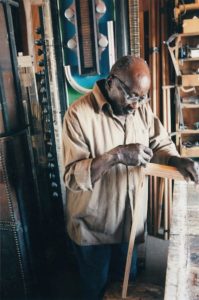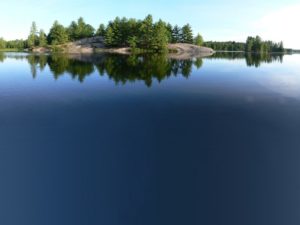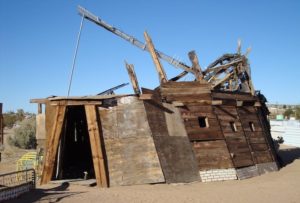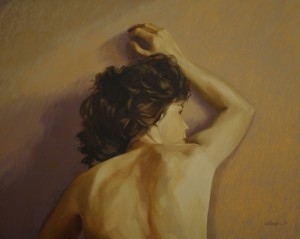Dear Artist,
Yesterday, Diana Miller-Pierce of Fort Wayne, Indiana wrote, “As a professional artist and practicing psychotherapist I’m particularly interested in the healing aspects of art. I hear from my clients a yearning to create in some manner. I’m wondering if in creativity they might experience the healing they need. Art therapy seems to me to have the potential to be the most powerful and far-reaching work. What’s your take on art as therapy?”
Thanks for that, Diana. “Art therapy” is a professional vocation that can exorcise a variety of devils as well as give a person a sense of self-worth. World wide, there are more than 7000 registered and practicing art therapists. There seems to be job opportunities in the field. “Art as therapy” presents another picture, but as usual, the edges are smudged.
A great deal of the art produced in art therapy is what I call “unfettered” art — that is it’s a free association “anything goes” art that attempts to do the same job as free journaling. While a matter of degree and open to exception, professional and serious artists are more likely to be “fettered.” They produce art that has norms of technique, standards and chemistry. This art is loaded with challenges that can produce a relatively benign form of stress. At the same time, art-making not only fills up the senses, but a few corners of the cortex as well. Furthermore, art carries one of the most deep-seated psychological values — birthing. Every work of art is a new offspring pushed out into the world as permanent evidence of personal fecundity. Don’t kid yourself, we’re into serious stuff here. A form of “creation therapy,” the making of art tunes into the natural unfolding of our universe. Creation therapy, whether understood by the artist or not, is one of the reasons why artists are some of the sanest folks around.
Art is a course in personal development that has no reliable diploma and no known end. The pursuit of art instructs in beauty as well as ugliness, fantasy as well as common sense. Art levels souls and baffles brains. Art softens pain because it is pain. Art gives joy because it is joy. Art is a form of love. Art is the ultimate gift. Art heals life.
Best regards,
Robert
PS: “Art is therapeutic for the audience as well as the artist.” (Bonnie Sherr Klein)
Esoterica: The American Art Therapy Association (AATA) is dedicated to the idea that the creative process and art-making are healing and life enhancing. Founded in 1969, AATA is a not-for-profit organization of 4,750 professionals and students. They establish standards for art therapy education, ethics, and practice. AATA committees work on professional and educational development, national and regional symposia, publications, governmental affairs, public awareness and research.

Artist Noah Purifoy (1917-2004), founding member of the California Arts Council, which provides artist-in-the-community outreach programs including in prisons, schools, hospitals and seniors’ centers, pictured here in his studio in Joshua Tree, CA, circa 2004.
“I hope my work provides inspiration for a person to do today what they couldn’t do yesterday, no matter what it is. That’s art.” (Noah Purifoy)
This letter was originally published as “How art heals” on May 7, 2004.
Have you considered a Premium Artist Listing? With each letter, an artist is featured at the bottom of this page. The Premium Artist Listings are a means of connecting artist subscribers through their work. Proceeds from each listing contribute to the production of The Painter’s Keys.
“I do not wish to be an artist. I only wish that art enables me to be.” (Noah Purifoy)
“Junk art, assemblage art… it’s as close to human existence because it’s all the castoffs we are utilizing here. I won’t say that assemblage art is much like life itself, but it’s closer to existence than any other art form. Because it’s your shit that we’re remodeling… and you got rid of it.” (Noah Purifoy)
Featured Workshop
 This retreat is an homage to early pioneers of plein air painting. We canoe-in and camp, paddling every day to our painting locations. This is a self-catered trip. We provide the canoes, life jackets and instruction. You bring your own provisions, tents, etc. The scenery in Kawartha Highlands is fantastic. Bald rock faces, sparkling lakes, majestic trees. Every direction you turn is another painting. Your instructor, Keith Thirgood, has been camping and canoeing all his life, and teaching artists his own unique approach to painting for over 12 years. Learn how to find order in the chaos, control your colours and create paintings that work. Learn modern colour theory, values, shapes and lines, what makes for a good painting.
This retreat is an homage to early pioneers of plein air painting. We canoe-in and camp, paddling every day to our painting locations. This is a self-catered trip. We provide the canoes, life jackets and instruction. You bring your own provisions, tents, etc. The scenery in Kawartha Highlands is fantastic. Bald rock faces, sparkling lakes, majestic trees. Every direction you turn is another painting. Your instructor, Keith Thirgood, has been camping and canoeing all his life, and teaching artists his own unique approach to painting for over 12 years. Learn how to find order in the chaos, control your colours and create paintings that work. Learn modern colour theory, values, shapes and lines, what makes for a good painting.Featured Artist
My aim as a painter is to bring to life a slice of the world as I experience it. Light, color and form are my vocabulary.








20 Comments
I missed my calling. I was a psychologist in the 70’s until I suddenly found myself thinking back to Vietnam and experiencing full-blown episodes of panic, fear, and nightmares. I withdrew from everything and considered myself unfit to be a therapist. That went on for years, well into the 80’s, and I never went back to working in psychology. I chose to paint houses instead, and just wanted to be alone with my thoughts. In 1982, I was strapped for cash and wanted to get my sister’s something for Christmas. An old friend had given me a cigar box full of paints, a stack of canvas boards, and a handful of brushes years ago, and I decided to try my hand at painting portraits of their dogs. I got hooked on doing more, and while I continued to paint houses, the focused concentration of oil painting, learning as I went along, was so fulfilling that I slowly regained my composure and no longer experienced bouts of post traumatic stress. Now that I’m retired, I’ve taken that experience to different levels, working in watercolors and pencils, and in each case, the therapeutic value to me probably exceeds whatever value my paintings might have for someone else.
Thank you for sharing your story. I found it fascinating. I did not start painting until I retired nearly 20 years ago and I have found that painting has always helped me get through some vey tough times. When I am painting or collaging a picture, I am in another world. My grief, sadness or fear, is forgotten and when I finish, these negative feelings are diminished. Janice
That’s a good way to put it, Janice, “in another world.” That’s exactly what it feels like, and I think it’s one of the attractions of painting. Sometimes we just need to escape and find some relief from all of the things going on in the world, especially today. We can’t change the world, but we can change our own world.
One of my favorite lines from Julia Cameron’s bestselling book The Artist’s Way is “Paintings wait for us.” Although I add ‘but not forever…our dying future can motivate us to get off the dime.’ I’m glad to hear you found the transformative power of art making. When the student is ready the teacher appears. Continuing to show up at the easel or drawing table honors the mystery at the heart of life–where all creativity originates–to express what words alone cannot match. What you are creating is also creating you. I think that’s partly why not being attached to the results helps us gain freedom. Our ego stories are not the last word about who we are or were.
There are a lot of ways to look at it. Julia Cameron goes in-depth and spells out a lot of things that I think most of us know intuitively. It’s not just art, but almost everything we endeavor to do in life. I took up the violin quite a few years back, thinking, “This is going to be different.” As a learning process, it’s not; there is the same early struggle to make something of it, then a sense of progress, and finally a reinforcing will to do more based on the sense of enjoyment and pride that each stage produces. If that’s missing, I would imagine the creative effort stops, at least as it was localized to one particular form…i.e., painting, music, writing, cooking, etc., etc.
As Nietzsche said, “We have art in order not to die from the truth.”
I taught art to at-risk youth for more than 20 years. My students were angry, often abused (both mentally and physically), on some sort of anti-depressant — you name it, they had it. I remember one of my best students telling me, “I am frozen.” I replied, “What? What is going on?” She replied, “I can’t move forward. I can’t move backward. My mind is frozen. I do not know what is wrong with me.” I told her to go into my back room (I had a safe zone area) and just paint. Paint anything and paint often until you “paint whatever pain you have is painted out of you.” Needless to say, she did. She went on to graduate high school with a scholarship. She has a beautiful family now. To say the least, “Art healed her.” I have had numerous angry students who wanted to tear the room apart and told them, “Just paint. Just paint it out. Whatever comes to you, paint it out.” Art heals. It does. It literally saved the lives of many of my students.
From the photos of the amazing sculptures of Noah Purifoy, it looks like they may be gathered together in some sort of park or outdoor exhibition space. Is that so, and are any of these pieces exhibited anywhere? I’ll probably never see them as I live on the other side of the country, but maybe others closer might be interested. They are worth a trip to see.
Thanks, Liz. The Noah Purifoy Foundation, with its permanent outdoor sculpture park is located in Joshua Tree, California. http://www.noahpurifoy.com/
Purifoy’s work is also on view at the Palm Springs Art Museum, among other museums.
A list of exhibitions is here: http://www.noahpurifoy.com/bio-cv
I wrote a letter about Noah on February 1, 2019, after seeing his work for the first time.
“An American Artist” is here: https://painterskeys.com/an-american-artist/
In friendship,
Sara
Having suffered serious depression and spending a month in a psychiatric care facility, the only therapy that really helped me was creative therapy,; drawing and writing. It was and is cathartic for me and I agree that the analogy to birthing is very significant.
Having suffered serious depression and spending a month in a psychiatric care facility, the only therapy that really helped me was creative therapy,; drawing and writing. It was and is cathartic for me and I agree that the analogy to birthing is very significant.
https://www.youtube.com/watch?v=pcznBdkZMEs
An interesting take on art and healing for the viewer as well.
From: … Walter Pach, (VQR Winter 1936)
Have you seen them?” I asked Diego Rivera. He paused for a moment in his painting on the frescoes at the New Worker’s School and then, tranquilly resuming the rhythm of his brush, answered: “Not only have I seen them, but I helped to send them over here. I was in Moscow when the question arose of selling works of art from the public galleries. I was consulted about it, and I spoke strongly in favor of the idea.
Here are my reasons.
In the first place, from the purely Communist standpoint, it is our duty to share with others. The Russian museum had some six Van Eycks, the American museum had none: I considered that it would have been wrong to prevent a great city that wanted these works from obtaining them.
“Then, if the Revolution succeeds throughout the world, people will be able to travel about so freely that any Russian student who needs to see those Van Eycks will be able to go and consult them in New York, just as Americans will go to Europe for whatever studies they want to make. If the Revolution fails, nothing matters anyhow—and we, for our part, will have done our duty in supplying it with the sums that could be the very ones needed to carry it through a crisis.
“Finally, though you know what pleasure I derive from the works of the Old Masters, I do not think, any more than you do, that the world can live on its past.
The Revolution must produce its own art. The world of today is different from the world of the Middle Ages and the Renaissance, and only modern art can give it the sustenance of which it has such urgent need, a physical need, in the same sense that bread is one; for if bread restores certain bodily tissues that wear out from use, art restores certain tissues of the brain, and in a manner that nothing else can.”
I hope that scientists will furnish verification for that last statement of Rivera’s, which no one, to my knowledge, has ever made before, and which offers one of the best reasons for our faith in the importance of art. No artist needs more than his instinct to tell him of the greatness of his calling, but there is still a notion among the vast majority of people that art is a luxury, an agreeable possession for the rich, but not the fundamental necessity for all human beings which Rivera’s diagnosis affirms it to be—and correctly.
The painter’s logic, which has a persuasive quality habitual in his discussion of things, might be adopted intact by the Russians in their difficult task of justifying the dispersal of the national collections. Let us note in passing that their policy is the reverse of the one followed by peoples far richer in art.
The two greatest museums in Europe, the Louvre and the National Gallery, are still buying, sometimes for very high prices, and the Rijks Museum in Amsterdam, already possessing the finest group of Dutch pictures in the world, purchased the two Vermeers of the Six Collection some years ago, paying a great sum for them rather than take a chance of their being lost to Holland. Among other examples of solicitude for the art treasures of a country, one might recall Italy’s recent purchase of the Giorgione Madonna from Prince Giovannelli; the refusal by the Greek government of a simply fabulous, unheard of sum for the Hermes of Praxiteles; and the drastic restrictions on foreign excavations imposed by the Egyptian government.
Canadian Art Therapy Association
“In Canada, an undergraduate degree in fine arts, psychology, social work or counselling is required before entering one of the art therapy programs.”
We must be very careful, unless you are a trained art therapist, please do not assume the role of therapist.
Having said that, there is nothing quite as healing and magnificent as losing yourself in heart. Absolutely, creating art stimulates and takes you away from many day-to-day issues.
Please please please be careful not to assume the role of a true trained art therapist.
I have a friend who was the head of art therapy in University of Berlin… she would come here often because of the strength of our Canadian art therapists, and she thinks very very highly off the Canadian Art Therapy Association.
Enjoy…love…. get lost in art!
Just, please don’t assume the role of a highly trained art therapist. Thanks!
PS
As an artist, author,, speaker and teacher of children and adults, I know firsthand how powerful art is in our lives.
I’ve spent my life as an Arts Advocate.
There may have never been a more important time to engage in The Arts as right now.
Dulsatory.
A newspaper comic strip gave me my biggest insight into why I should–and have to–make my art. Can’t find it now, but there’s a copy in this article I wrote awhile back: https://luannudell.wordpress.com/2016/03/11/go-forth-and-make-stuff/ (I write about this one a LOT, because it’s astonishingly beautiful.)
I am primarily an artist but also a psychotherapist; and organize group shows on specific themes. Several years ago I put together a show I called Art Heals in which I asked artists to create a work of art with a specific trauma in mind to work out some, possible, healing from the art-making process. Twenty-one artists involved themselves and I hung the show in the beautiful little art gallery at the Ontario Shores Mental Health Centre in Durham Region in Ontario (where I am a volunteer). The local federal member of parliament found out about the show and asked to attend and speak at the opening. She revealed there, for the first time in public, that she has suffered from serious depression for quite some time and wanted to support our efforts. Many of the artists talked about the motivation for their piece and the effects the making of the art had on them. There were many tears and many ah-ha moments in a hugely cathartic and healing evening.
As a painter I have experienced the physical release of pain and emotional release of pain through painting. Even so because of self imposed discouragement I stopped painting for six years until my counselor gave me a homework assignment to create a piece of art. I made a mixed media collage and it was titled ‘Cartwheel’ . It really was a turning point in my life because I started a regular practice of studio painting and mixed media artwork that to this day has been a blessing in my life and in the lives of people I teach. I’m so thankful for your insightful letters Sara. Thank you for carrying on your Dad’s legacy of encouraging and understanding Artists.
“What the world needs now is….” paint brushes, canvas and soft globs of sculpting clay or just use their recycling trash to express!!!! Yep !!!!
This brings to mind three specific memories I have of the use of art for expressing pain and for healing. One was of a very troubled 8 year old student with significant attention and anger issues such that he was unable to complete any schoolwork in class. I happened to have an origami centre in my room, and one day, in a fit of rage, he went there and completed an extraordinarily difficult folding endeavour of a 3D dinosaur head complete with many sharp teeth having never had any particular instruction in origami. I was amazed at his ability to channel his anger and focus. For another 8 year old student, also with significant social/emotional difficulties and prone to bouts of rage, I had a ready supply of paint and paper because otherwise he was inclined to mark all over the walls and table tops. Two years later, when I left that school, he wrote me a card saying, simply, “Thank you for teaching me to paint.” The third memory I have is of a time when I participated in a mixed media creative activity that involved a sharing circle at the end. I was in a time of grief and depression and created what I thought was a small, insignificant piece. During the sharing session, one of the other participants remarked on how my piece in particular spoke to her deeply because it brought to her mind memories of peaceful wilderness kayak journeys. Later I found out she had been recently diagnosed with a significant return of cancer and that my piece offered an image of happier times. I was profoundly influenced by her story and the power of art to transport. As many have said before me, thank you Sara, for carrying on this wonderful newsletter. Whether it offers something to reflect upon or learn, or evokes or instills memories, I have always found it to be worth reading.
Sara, I look forward to your letters as much as I did my family’s mail in the past. Your dad’s entire letter, this subject and all the comments have my heart racing from excitement and my head nodding in agreement.
THANK YOU as always!